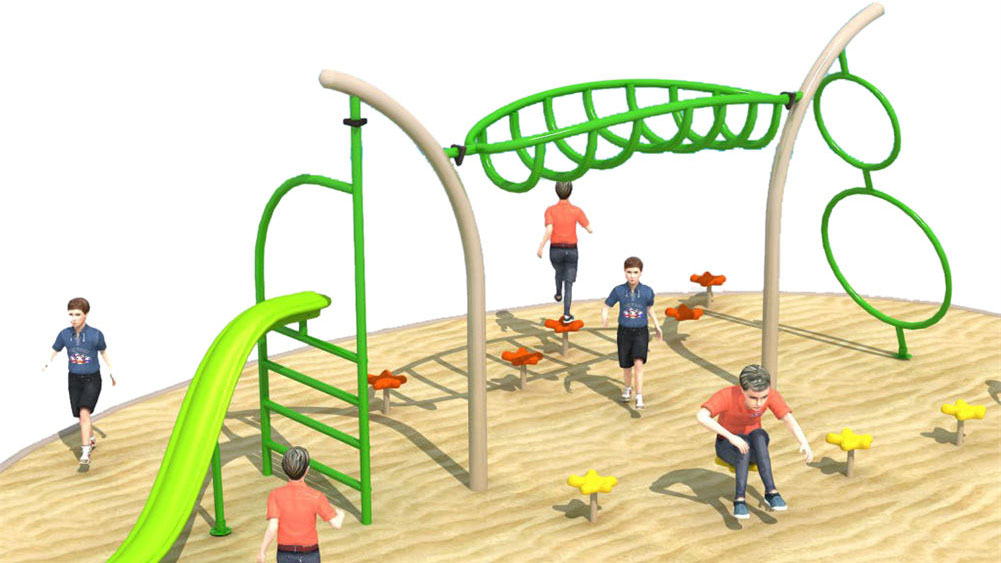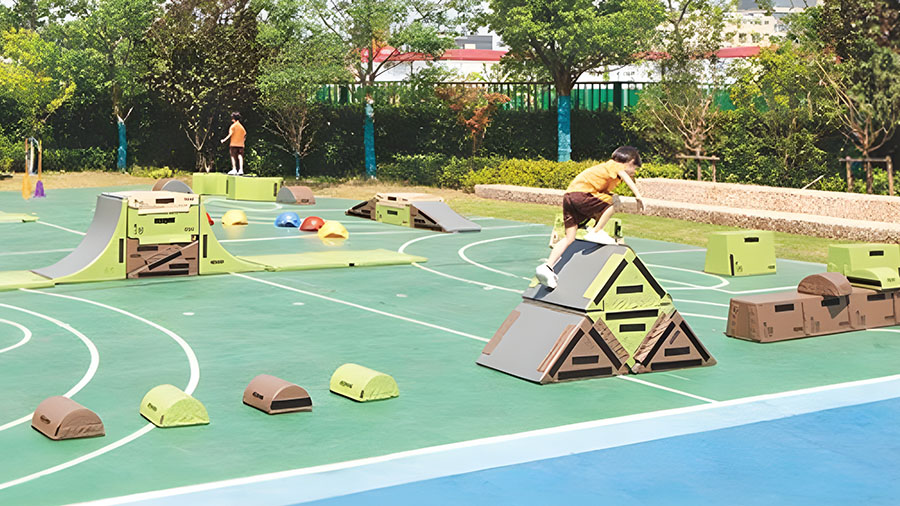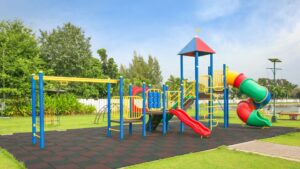Детские площадки - это важное место для игр, занятий спортом и развития важных физических и социальных навыков. Если вы планируете детскую площадку для школы, парка или общественного центра, понимание различных типов оборудования для детских площадок является ключевым моментом. В этом глоссарии мы рассмотрим распространенные названия оборудования для детских площадок и их функции, чтобы вы были вооружены необходимыми знаниями при планировании следующего проекта детской площадки.
Знакомство с игровыми площадками
Игровые площадки предлагают детям безопасную и стимулирующую среду для развития основных навыков, от физической активности до социального взаимодействия. Хорошо спроектированные игровые площадки подходят для детей разных возрастных групп и способностей, предлагая разнообразное игровое оборудование, такое как качели, горки и скалодромы, которые способствуют развитию. Понимание различных терминов и категорий оборудования для детских площадок поможет вам создать веселое и функциональное пространство для детей.
Традиционные названия оборудования для детских площадок
Со временем оборудование для детских площадок эволюционировало, чтобы соответствовать современным стандартам безопасности. Некоторые из привычных элементов были обновлены или переименованы для повышения безопасности и доступности. Давайте рассмотрим традиционные названия оборудования для детских площадок и современные вариации каждого элемента.
1. Карусель
Также известен как спиннеры, карусели, или каруселиКарусели - это классические любимцы детских площадок, где дети крутятся, толкая оборудование. Хотя термин "карусель" все еще распространен, он часто используется как взаимозаменяемый с термином "карусель". Вращающееся игровое оборудованиеОна была разработана в соответствии с современными требованиями безопасности, установленными CPSC (Комиссия по безопасности потребительских товаров).
2. Seesaw (Teeter-Totter)
Сайт Качели, также известный как teeter-totterпозволяет двум детям ездить вверх и вниз. Новые функции безопасности, такие как пружинные центры для амортизации ударов, заменили старые версии. Максимальный угол наклона традиционных качелей теперь ограничен 25 градусов для обеспечения безопасной игры.
3. Гигантский шаг
Сайт гигантский шаг когда-то был популярным элементом игровой площадки, представлявшим собой высокий столб со свисающими вниз веревками. Дети держались за веревки и бегали по ним, создавая вращательное движение. Однако из-за проблем с безопасностью это оборудование было снято с производства и больше не рекомендуется CPSC.

4. Обезьяньи бары
Брусья для обезьян Это горизонтальные лестницы, подвешенные над землей, на которых дети качаются с перекладины на перекладину, развивая силу и координацию верхней части тела. С годами они приобрели различные формы, например кольцевые альпинисты или верхолазыПредлагая детям более сложный и динамичный опыт.
5. Кольца
Все еще звенитПохожие на те, что используются в гимнастике, они подвешены на цепях и позволяют детям тренироваться в висе и раскачивании. Их часто называют терапевтические кольца для рук благодаря своим преимуществам в развитии силы верхней части тела.

Современные названия оборудования для детских площадок
Современные игровые площадки оснащены целым рядом нового оборудования, призванного обеспечить максимальное удовольствие, безопасность и доступность. Добавление инновационного оборудования способствует активная игра, координация, и критическое мышление. Вот взгляд на современные названия оборудования для детских площадок, которые создают волны в сегодняшнем дизайне игровых площадок.
1. Качели
Качели остаются одним из основных элементов детской площадки, но существует множество их разновидностей:
- Ускоритель качания: Большие, похожие на диск качели, на которых могут кататься сразу несколько детей.
- Поколение Качели: Качели, сочетающие в себе закрытое сиденье для малышей и открытое сиденье для взрослых, способствуют общению всей семьи.
- Качели "Гадюка: Групповые качели с веревочной конструкцией, где сотрудничество является ключевым фактором для достижения движения.
- Качающееся сиденье Inclusive: Предназначенные для детей с разными способностями, эти сиденья обеспечивают безопасную и комфортную поездку для детей с разными потребностями.
2. Слайды
Горки по-прежнему остаются одним из самых любимых видов оборудования для детских площадок. Разновидности включают:
- Слайды для трубок: Закрытые горки для захватывающего и быстрого катания.
- Изогнутые полозья: Волнистые или спиральные горки, которые придают аттракциону дополнительное волнение.
- Слайды башни: Отдельно стоящие горки, прикрепленные к конструкции, напоминающей башню, идеально подходят для больших игровых систем.
3. Игровые скалолазы
Скалолазы - это увлекательный способ для детей развить силу и координацию. Современные скалодромы выпускаются в различных формах:
- Геодезические скалолазы: Куполообразные скалодромы из соединенных между собой металлических треугольников.
- Лозоходцы: Скалолазы, напоминающие натуральные лианы, для любителей приключений.
- Вертикальные стены для скалолазания: Для детей постарше вертикальные стены предлагают более сложный подъем.
4. Весенние всадники
Это классические изделия, которые остаются веселым элементом игры, способствующим развитию воображения. Пружинные наездники часто принимают форму животных или транспортных средств и позволяют детям подпрыгивать вперед и назад, развивая равновесие и координацию.

5. Спиннеры
Спиннеры похожи на старые карусели, но имеют более современный дизайн и более безопасные функции. К ним относятся:
- Спиннер для катания на бочках
- Спиннер для седла
- Вихревой спиннер
Они обеспечивают головокружительное вращение и помогают развить у ребенка чувство равновесия и координацию.

6. Сенсорное игровое оборудование
Сенсорное игровое оборудование Задействует органы чувств детей, развивая когнитивные и моторные навыки. Она может включать в себя:
- Музыкальные панели: Такие инструменты, как Ксилофоны и барабаны стимулирующие слуховые ощущения.
- Тактильные игровые панели: Текстурированные панели, предназначенные для восприятия на ощупь.
- Сенсорные дорожки: Тропинки, побуждающие к исследованию различных текстур.

Удобства на участке
При проектировании детской площадки удобства на участке не менее важны, чем игровое оборудование. Они обеспечивают комфорт и удобство для родителей и воспитателей. Общие удобства на территории включают:
- Скамейки
- Столы для пикника
- Мусорные контейнеры
- Велосипедные стойки
Эти элементы помогают превратить детскую площадку в гостеприимное пространство для всех.
Заключение: Понимание терминологии оборудования игровых площадок
Знание терминов, обозначающих оборудование для детских площадок, поможет вам принять более правильное решение при проектировании или модернизации игровой площадки. С сайта качели на спиннеры и сенсорные панелиКаждый элемент оборудования служит уникальной цели, способствуя развитию физической активности, социальных навыков и воображения. Приоритет безопасности, доступности и инклюзивности гарантирует, что игровая площадка будет приятной и безопасной для всех детей.




